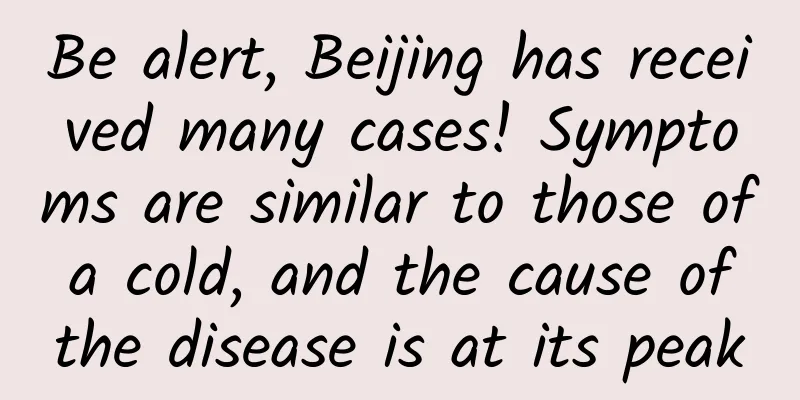Be alert, Beijing has received many cases! Symptoms are similar to those of a cold, and the cause of the disease is at its peak

|
According to the People's Daily Health Client: "After this rainstorm, my entire respiratory tract tightened, especially on the night of the thunder and the next day, I had obvious asthma symptoms." On September 5, at the outpatient department of the Allergy Department of Beijing Century Memorial Hospital, a Beijing patient told reporters that in the past, the symptoms of rhinitis would be relatively alleviated when it rained, but this time they were significantly worse. The patient was diagnosed with "thunderstorm asthma." Wang Xueyan, director of the Allergy Center of Beijing Century Altar Hospital, told reporters that in recent days, Beijing Century Altar Hospital has received 6 patients with "thunderstorm asthma", and the peak season of autumn pollen in northern my country is expected to last for 2-3 weeks, so patients with allergies due to thunderstorm weather need to pay special attention. On September 5, allergy patients waited for diagnosis and treatment outside the outpatient department of the Beijing Century Altar Hospital. Photo by Xu Shiyu The key to "thunderstorm asthma" is "lightning strike". Wang Xueyan introduced that in thunderstorm weather, the wind blows up allergens such as pollen and mold. After the lightning strike, these allergens are broken into smaller particles, which are more easily inhaled by the human body, causing or aggravating asthma symptoms such as coughing, chest tightness, shortness of breath, and difficulty breathing, which is called "thunderstorm asthma". In Wang Xueyan's opinion, thunderstorm asthma has gradually become a collective disease. Many allergy patients have experienced a certain degree of aggravated symptoms after thunderstorms, which are difficult to recover for several days. "The northern part of my country has entered the peak season of pollen allergy in autumn, which is expected to last for another two to three weeks." Wang Xueyan reminded that patients who have been diagnosed with pollen allergy need to use medication in a standardized manner, and undiagnosed patients should not mistake pollen allergy for a cold and delay treatment. Once thunderstorms begin, allergy patients should reduce outdoor activities, strengthen protection when going out, and remember to wear masks and protective glasses. After the heavy rain, the number of patients with cough and asthma increased Some hospitals see more than 800 patients a day Recently, many netizens in Hohhot, Inner Mongolia, posted videos showing a long queue at a hospital's asthma clinic and a crowded hospital lobby. A doctor said, "Asthma patients, come to me and take a picture of the medicine name to buy it. If you don't know how to use the medicine, I will teach you." Another doctor explained to the patient's family, "It's because the pollen concentration is too high." Image taken from video Mr. Li, a family member of the patient, said that after the rain, the child suddenly felt difficulty breathing, which might be due to the high concentration of pollen and the child's poor resistance. After arriving at the hospital, many people came to see this disease, and he had never encountered a similar situation before. After treatment, the child has improved. A pediatric staff member from the Affiliated Hospital of Inner Mongolia Medical University said that more than 800 people came to the hospital for this disease yesterday. They can rinse the nose with saline solution to wash away the pollen in the nose, which can alleviate the symptoms. Pollen allergy closely linked to thunderstorm asthma Dr. Wang Wenping from Beijing Century Altar Hospital said that it is generally believed that seasonal allergic rhinitis caused by seasonal grass pollen allergy is the most sensitive risk factor for thunderstorm asthma. Among patients with thunderstorm asthma, the prevalence of seasonal allergic rhinitis is as high as 60% to 99%, of which 70% present with moderate or severe allergic rhinitis. Studies have found that among patients with thunderstorm asthma, the previous asthma diagnosis rate is 22% to 42%, and more than half of the patients have never been diagnosed with asthma, but still have asthma-related symptoms. Current asthma and hospitalization for asthma in the past 12 months are considered risk factors for hospitalization for thunderstorm asthma. Therefore, pollen allergy is closely related to thunderstorm asthma. Patients should actively treat pollen allergy to prevent the occurrence of allergic asthma. It is recommended to receive preventive pollen allergen-specific immunotherapy to form "immune tolerance" to pollen allergens and achieve "desensitization". During the thunderstorm season of pollen season, try to reduce pollen contact and use anti-allergic drugs preventively to avoid accidents. How to prevent "thunderstorm asthma"? 1 What is thunderstorm asthma? Thunderstorm asthma refers to an acute attack of respiratory diseases such as asthma caused by thunderstorms. The symptoms are severe and the disease progresses rapidly, usually in groups, with many patients having attacks at the same time. Why do thunderstorms exacerbate allergies? Thunderstorm asthma occurs during pollen season. Some studies suggest that cold air currents before thunderstorms can carry pollen or mold particles into clouds, where moisture and lightning can cause the pollen particles to burst, releasing smaller particles. Pollen particles that return to the ground are smaller and more easily enter the respiratory tract. In addition, the strong electric field generated by thunderstorms may increase the allergenicity of allergens released by pollen, making them more harmful. Simply put, the strong wind before the thunderstorm carries the pollen into the sky, and then the thunderstorm breaks the pollen into pieces. These fragments of pollen, amplified by the strong electric field generated by thunderstorms, finally flexibly penetrate into your nasal cavity and cause asthma. 3 How to prevent it? First, it is recommended to close doors and windows and stay indoors when thunderstorms occur. More importantly, even if the sun is shining after a thunderstorm, you should stay indoors for a while. Because the evaporation of rainwater will bring a large number of small particles broken by thunderstorms into the air. Secondly, if your child has been diagnosed with allergic rhinitis or bronchial asthma, you must adhere to standardized medication and regular follow-up visits during the rainy season. You can also ask your doctor to prepare preventive and relief drugs for you in advance, so that you can handle the acute attack yourself and go to the hospital as soon as possible if necessary. Finally, you can rinse your nose and face with salt water or clean water after returning from the outdoors. If conditions permit, you can use an air purifier. Source: Beijing Evening News, People's Daily Online Popular Science Comprehensive Hangzhou Daily, Comprehensive Baoyi Second Affiliated Hospital, Jiupai News, Jimu News, Red Star News, Inner Mongolia Weather, China News Network. |
>>: Which is better, vitamin C that costs 2 yuan or vitamin C that costs hundreds of yuan?
Recommend
How to recover from back pain after childbirth?
Many mothers will report that lower back pain is ...
How to deal with masks after 4 hours of use? Popular knowledge of mask standards
At present, masks are out of stock nationwide. In...
When the autumn wind blows, crabs are in season. Should pregnant women eat them?
This is the 4571th article of Da Yi Xiao Hu Anoth...
People with low blood sugar should not lose weight blindly, let's take a look
Losing weight has always been a hot topic. There ...
The World Health Organization announced that it will be completely eradicated by the end of 2023! All about its files and "crimes" are explained at once
Image from: freepik.com Recently, the World Healt...
How to open the back of a shrimp? How to choose and buy shrimp
Shrimp is loved by many friends because it contai...
Female lower back pain on the right side
The waist is a very important part of the body, s...
I especially want it before and after my period.
Many women are too shy to express themselves when...
What should I do if my earwax is too much and hard?
A netizen asked: A few days ago, my daughter said...
Why is my bladder "cramping"? - Bladder spasms after catheterization
In daily life, sometimes we may need to use a cat...
What is labor pain?
Many people may have heard of this saying: the la...
What is the normal size of a woman's vulva?
In China, due to the lack of sexual knowledge, ma...
Experian: Data shows that Singapore users spend the most time on Facebook each time they visit
According to a report by British analysis company...
What to do if women have itchy lower body
I believe that many female friends have encounter...
Lipid crisis: revealing the truth about acute hyperlipidemic pancreatitis
This is the 5289th article of Da Yi Xiao Hu Today...









